
Hongguang Chen, Konglai Zhang
European Respiratory Journal 2020; DOI: 10.1183/13993003.02710-2020
Dear editor
We are interested in an article published in the journal recently, entitled “The potential impact of COVID-19-related disruption on tuberculosis (TB) burden”. The study used a mathematical model to estimate the relative impact of reductions in social contacts and health services on TB burden due to the COVID-19 epidemic. There included data and projections on China, being one of 22 high TB burden countries for both TB and multidrug resistant TB cases. COVID-19, which has spread rapidly and enveloped most of the world, is a unique global public health crisis for the century. By the end of January 2020, The World Health Organization declared COVID-19 outbreak a global health emergency and called for moves to stop the transmission of this virus. Accordingly, comprehensive and large-scale preventive and control measures were launched in February 2020. As McQuaid's study reported, COVID-19 outbreak had an impact on both short-term and long-term global tuberculosis control. In addition to model prediction, little is known about the specific impact of COVID epidemic on TB. Here, we compared the actual epidemic data on tuberculosis released monthly by the China National Health Commission from February to May of 2019 and 2020. In 2020, the numbers of newly registered patients with TB nationwide from February to May were 67 682, 44 933, 73 427, 85 684 and 83 385 , with a decrease of 24%, 39%, 25%, 15% and 13% respectively compared to the same periods in the previous year (fig. 1). Over the same period in 2020, the number of confirmed cases with COVID-19 peaked 68 033 in February and has been sharply declining since March. Only 143 cases were reported nationwide in May, a decrease of 99.8% from the peak. The declines in TB registrations may partly be related to the COVID-19 epidemic, especially in Feb 2020. The above figures indicated that COVID-19 outbreak might serve as a double-edged sword for TB control. On the one hand, comprehensive preventive measure against COVID-19, including self-quarantine, social distancing and wearing facial masks, had reduced the spread of TB transmission in the community. In addition, early in the COVID-19 outbreak, large number of COVID-19 cases were identified and hospitalised within a short period of time, disrupting other routine medical practices and medical resources. Designated hospitals used to be serving for tuberculosis diagnosis and treatment had been temporarily identified as designated hospitals for COVID-19 diagnosis and treatment. Meanwhile, suspected and confirmed TB cases might be reluctant to go to the hospital for fear of COVID-19 infection. This might cause diagnostic delay for the suspected TB patients but increase the risk of TB transmission in households and communities. Figures showed that numbers of newly registered TB cases increased after the COVID-19 was gradually brought under control from March, 2020. And the gap was also narrowing month by month compared with the same periods in the previous year. Both the numbers of new TB infections due to the delay of diagnosis and treatment of the source of infections during the COVID-19 epidemic and of TB cases reduced by comprehensive measures against COVID-19 are worthy of further study. The disclosure of national TB registration data in the coming months may provide a better answer. The above mentioned situation only reflected the impact of COVID-19 outbreak on TB epidemic at the national level; however, there might have been different pictures at the provinces depending on the severity of local COVID-19 epidemic. In addition, there might be other interaction and causality deserved to be explored between COVID-19 and TB, such as whether the COVID-19 cases would boost the development of active TB, or vice versa. It was also reported that COVID-19 had a modest impact on clinical symptoms and prognosis of anti-TB treatment in the short term but long-term impact still needed to be explored.
FIGURE 1
Comparisons of newly registered TB nationwide in China from Jan to May of 2019 and 2020*. Note: “*” Number of confirmed COVID-19 cases peaked 68 033 in Feb and has been declining sharply since March, with only 143 cases reported nationwide in May.
In the long run, we do not think that the number of TB cases and deaths will increase as predicted by the model reported in McQuaid's study. Firstly, population-based comprehensive interventions against COVID-19 have been well implemented and proved to be effective and the spread of the virus has almost been tamed in China. It is assumed that COVID-19 epidemic might be resurgent again; nevertheless it should be at the local level and would be brought under control within a short period. The control of COVID-19 epidemic related to Xinfadi market in Beijing verified the assumption. Thirdly, COVID-19 not only saddles on disaster, but also provides experience in fighting against TB. People of all walks of life have learned and practiced on the intervention programs related to respiratory infectious diseases i.e. personal hygiene and protection including wearing masks in particular. In addition, the government is also taking this opportunity to further improve the public health infrastructure. The above measures will also enhance the capacity in diagnosis, treatment and management of TB patients so as to reduce the disease burden of TB.
Footnotes
-
Support statement: This research did not receive any specific grant from funding agencies from the public, commercial, or not-for-profit sectors.
-
Author contributions: All authors certify that they have participated sufficiently in this work. Each author certifies that this material has not been submitted to or published in any other publication. All authors approved the final version of the manuscript.
-
Conflict of interest: Dr. CHEN has nothing to disclose.
-
Conflict of interest: Dr. ZHANG has nothing to disclose.
- Received July 9, 2020.
- Accepted July 14, 2020.
- Copyright ©ERS 2020















